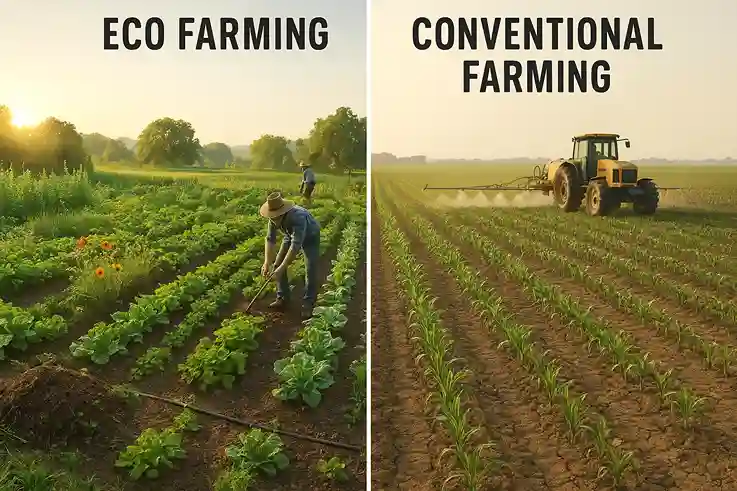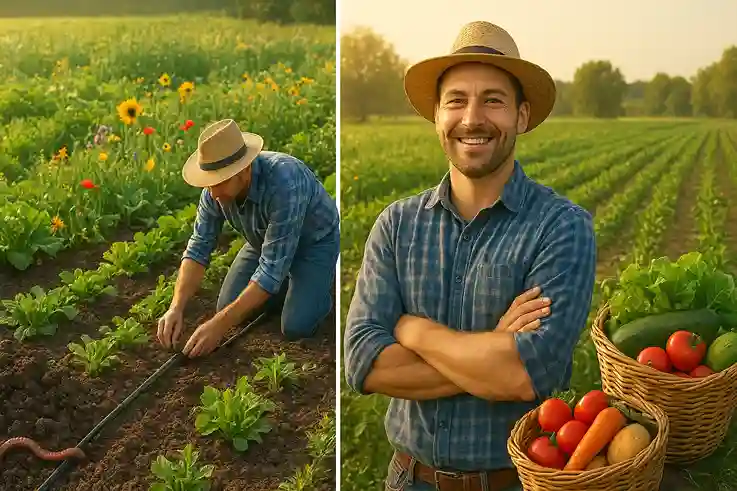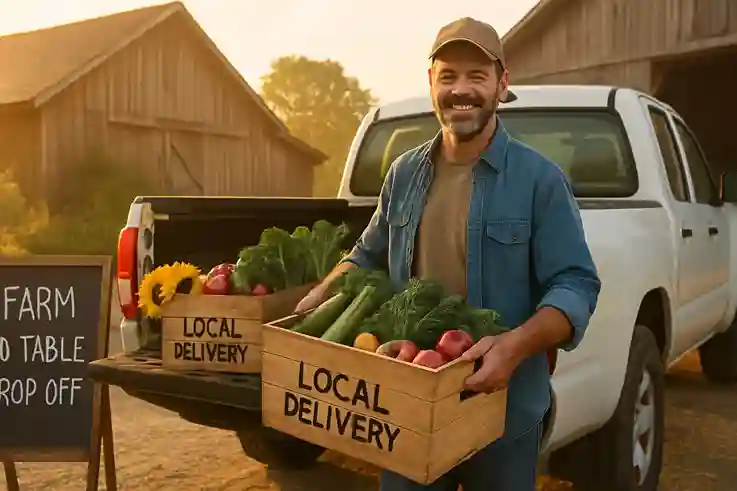Eco Farming: A Path to Sustainable and Fulfilling Living
Eco farming is a sustainable approach to agriculture that works with nature rather than against it. It focuses on protecting soil health, conserving water, and supporting biodiversity while still producing nutritious food. By replacing heavy chemical use with natural, regenerative methods, eco farming helps farmers create a balance between productivity and environmental care.
This approach does more than protect the planet—it can also bring a richer, more fulfilling lifestyle. Many farmers find deeper satisfaction in knowing their work benefits both people and nature.
In this guide, you’ll learn the core principles of eco farming, practical methods to start your own journey, inspiring success stories, and solutions to common challenges. You’ll see how eco farming can transform not just your land, but your entire way of life.
What Is Eco Farming?
Eco farming is a holistic approach to agriculture that blends traditional wisdom with modern sustainability practices. It aims to produce food while preserving natural resources, reducing waste, and protecting ecosystems. This method focuses on harmony between farming activities and the environment.
Core Principles of Eco Farming

Soil Health First
Healthy soil is the foundation of eco farming. Instead of relying on synthetic fertilizers, farmers enrich the soil with compost, manure, and other organic matter. Minimal tillage helps preserve soil structure and prevents erosion. Over time, these practices boost microbial activity, which improves nutrient availability and water retention, leading to stronger, healthier crops.
Biodiversity Protection
Eco farming values the natural balance between plants, animals, and insects. Farmers plant a variety of crops and maintain natural habitats to attract pollinators and beneficial wildlife. This diversity strengthens the ecosystem, reduces disease outbreaks, and ensures the land remains fertile and productive for future generations.
Water Conservation
Water is a precious resource, and eco farming prioritizes using it wisely. Techniques like drip irrigation, mulching, and rainwater harvesting reduce water waste and keep plants hydrated efficiently. By maintaining soil organic matter, eco farms also help the land retain more moisture, lowering the need for frequent irrigation.
Natural Pest Control
Instead of chemical pesticides, eco farmers turn to nature’s own defense systems. Beneficial insects like ladybugs and lacewings keep harmful pests in check. Crop rotation disrupts pest life cycles, while companion planting can naturally repel unwanted insects. These strategies maintain crop health without contaminating the soil or water.
Sustainable Resource Use
Eco farming minimizes the use of non-renewable resources and avoids waste. Farmers recycle plant residues, use renewable energy sources where possible, and produce animal feed or compost from farm byproducts. This closed-loop system keeps the farm self-sustaining and reduces its environmental footprint.
How Eco Farming Differs from Conventional Farming

While conventional farming often focuses on achieving maximum yields through synthetic fertilizers, pesticides, and intensive land use, eco farming places environmental health, long-term soil fertility, and resource conservation at the center of its practices. It avoids harmful methods, even if that means slower short-term production gains. The goal is to create a balance between productivity and sustainability, ensuring the land can feed future generations.
Key Differences at a Glance
| Aspect | Eco Farming | Conventional Farming |
|---|---|---|
| Soil Management | Builds soil health with compost, cover crops, and minimal tillage | Relies on synthetic fertilizers and frequent tillage |
| Pest Control | Uses natural predators, crop rotation, and companion planting | Applies chemical pesticides for quick pest elimination |
| Water Use | Prioritizes efficiency through drip irrigation, mulching, and rainwater harvesting | Often uses high-volume irrigation with less focus on conservation |
| Biodiversity | Encourages diverse crops, wildlife habitats, and pollinator support | Typically practices monocropping, which can reduce biodiversity |
| Environmental Impact | Reduces pollution, preserves ecosystems, and limits carbon footprint | May cause soil degradation, water pollution, and higher emissions |
| Long-Term Sustainability | Focuses on regenerative practices for future productivity | Prioritizes immediate yield, sometimes at the cost of long-term soil health |
By understanding these differences, farmers and consumers can make informed choices that support both food production and environmental preservation.
Why Eco Farming Matters Today
Addressing Climate Change
Eco farming plays a key role in reducing greenhouse gas emissions. By avoiding synthetic fertilizers—which release nitrous oxide, a potent greenhouse gas—it prevents one major source of agricultural pollution. At the same time, eco farming increases soil carbon storage through compost, cover crops, and other organic matter. Healthy soils act as natural carbon sinks, trapping carbon in the ground instead of letting it enter the atmosphere. Over time, this helps slow the pace of global warming while improving the land’s overall fertility.
Combating Soil Degradation
Industrial farming practices, such as over-tillage and excessive chemical use, often strip the land of essential nutrients. This leads to erosion, loss of organic matter, and declining soil fertility. Over time, degraded soils require heavier chemical inputs to produce the same yields, creating a damaging cycle. Eco farming breaks this cycle by focusing on soil restoration. Through composting, crop rotation, and the use of cover crops, it replenishes nutrients, improves soil structure, and boosts water retention. These methods ensure that the land remains productive, resilient, and healthy for generations to come.
Protecting Biodiversity
Modern monocropping systems focus on growing a single crop across large areas, which reduces the variety of plants and disrupts natural ecosystems. This loss of diversity makes farmland more vulnerable to pests, diseases, and environmental stress. Eco farming reverses this decline by planting a mix of crops and maintaining natural habitats around fields. Hedgerows, wildflower strips, and small water bodies create safe spaces for pollinators, beneficial insects, and native wildlife. By supporting these species, eco farming strengthens the natural balance, reduces the need for chemical interventions, and helps ecosystems thrive.
Ensuring Food Security
Eco farming strengthens food production by focusing on soil fertility and efficient water use. Healthy, nutrient-rich soils produce more resilient crops that can better withstand environmental stresses like droughts, floods, and temperature extremes. Water-saving methods, such as drip irrigation and rainwater harvesting, ensure that farms remain productive even during dry seasons. This stability benefits both local communities and global markets, reducing the risk of supply disruptions. By building agricultural systems that adapt to changing climates, eco farming helps secure a steady, reliable food supply for present and future generations.
Building Resilient Communities
Eco farming often operates within local food systems, where produce is grown, sold, and consumed within the same region. Community-supported agriculture (CSA) programs and farmer cooperatives allow producers to share resources, reduce costs, and market their goods directly to consumers. This direct connection builds trust and transparency, as customers know exactly where and how their food is grown. In turn, local economies benefit from keeping more money within the community. Beyond economics, these networks create a sense of shared responsibility for land stewardship, fostering cooperation, mutual support, and long-term resilience.
By embracing eco farming, farmers take an active role in preserving the planet’s health while also improving their own quality of life and that of their communities.
The Core Benefits of Eco Farming

Environmental Benefits
Eco farming helps protect and restore natural systems. By building healthy soils through composting and minimal tillage, farmers create conditions where crops thrive without synthetic fertilizers. Biodiversity flourishes when multiple crops, wildlife habitats, and pollinator-friendly plants are introduced. Water conservation techniques like drip irrigation and mulching reduce waste, protect aquifers, and keep waterways clean. Together, these practices reduce the environmental footprint of farming while strengthening the resilience of the land.
Economic Benefits
While eco farming may require more planning and manual work initially, it often reduces costs in the long run. Savings come from eliminating expensive synthetic inputs, improving soil productivity, and using resources more efficiently. Many eco farms also benefit from selling premium-quality produce at higher prices to markets that value sustainably grown food. By maintaining soil fertility and ecosystem health, farms remain productive for decades, avoiding the costly cycle of land degradation and restoration.
Emotional Benefits
Eco farming offers rewards beyond crops and income. Many farmers experience a strong sense of purpose knowing their work protects the environment and supports healthier communities. Working closely with the land fosters a deep connection to nature and a more mindful, balanced lifestyle. The visible results—rich soil, thriving wildlife, and healthy harvests—bring satisfaction that purely profit-driven farming rarely provides.
Essential Eco Farming Practices
Organic Soil Management
Healthy soil is the backbone of eco farming. Instead of relying on synthetic fertilizers, farmers use compost, animal manure, and green manure crops to enrich the soil naturally. Minimal tillage preserves soil structure, reduces erosion, and encourages beneficial microbes. Cover crops add nutrients, improve moisture retention, and protect soil during off-seasons, ensuring consistent fertility year-round.
Crop Rotation and Diversification
Planting the same crop repeatedly in one location depletes specific nutrients and encourages pest build-up. Crop rotation breaks these cycles, restoring balance to the soil and reducing disease risk. Diversifying crops not only improves soil health but also spreads economic risk—if one crop fails, others can still thrive. This variety supports biodiversity, creating a more stable farming ecosystem.
Natural Pest and Weed Control
Eco farming avoids harmful chemical pesticides and herbicides. Instead, farmers encourage beneficial insects like ladybugs and lacewings to control pests naturally. Companion planting, such as growing marigolds near vegetables, helps repel harmful insects. For weeds, techniques like mulching, crop spacing, and manual removal maintain control without damaging the soil or surrounding ecosystems.
Water-Efficient Irrigation Methods
Water is a limited resource, and eco farming prioritizes using it wisely. Drip irrigation delivers water directly to plant roots, minimizing evaporation. Rainwater harvesting collects and stores water for dry periods, while mulching keeps the soil cool and moist. These methods conserve water, lower costs, and help farms remain productive even during droughts.
Starting Your Eco Farming Journey

Planning Your Farm Layout
A successful eco farm starts with a thoughtful layout. Consider factors such as sunlight, wind direction, and natural water flow. Place crops in areas where they receive optimal light and protection from harsh weather. Design pathways for easy access without compacting the soil, and reserve spaces for composting, water storage, and biodiversity zones like hedgerows or pollinator gardens.
Choosing Suitable Crops or Livestock
Select crops or animals suited to your local climate, soil type, and available resources. Native or regionally adapted plant varieties tend to require fewer inputs and withstand pests better. If raising livestock, choose breeds known for resilience and compatibility with pasture-based systems. Balancing crops and livestock can create a self-sustaining cycle where waste from one benefits the other.
Sourcing Eco-Friendly Seeds and Materials
Opt for organic, non-GMO seeds to maintain purity and biodiversity. Look for suppliers who prioritize seed-saving and sustainability. Use natural materials for fencing, mulching, and soil amendments to avoid introducing harmful chemicals. Whenever possible, repurpose or recycle farm tools and building materials to minimize waste.
Starting Small vs. Scaling Up
For beginners, starting on a small scale allows you to test methods, learn from mistakes, and refine your approach without overwhelming costs. As skills and confidence grow, you can expand gradually, adding more crops, animals, or infrastructure. Scaling up mindfully ensures your farm remains sustainable, manageable, and financially viable in the long run.
Real-Life Success Stories
From Struggling Farm to Agri-Tourism Success
Maria Lopez inherited a small farm in Vermont that had been losing money for years. Instead of following conventional methods, she switched to eco farming—focusing on organic vegetables, native wildflowers, and a pollinator-friendly orchard. To supplement her income, Maria opened the farm to visitors, offering guided tours, seasonal fruit-picking events, and eco-friendly cooking classes. This shift to agri-tourism not only improved her income but also educated the public about sustainable agriculture. Within three years, her farm became a local landmark, attracting school trips, eco-conscious travelers, and food enthusiasts from nearby cities.
Urban Vertical Farming with an Eco Focus
In downtown Chicago, Kevin and his team transformed a vacant warehouse into a vertical eco farm. Using hydroponics powered by solar energy, they grew leafy greens, herbs, and microgreens year-round. By recycling water and using organic nutrients, Kevin maintained zero waste while producing fresh food for local restaurants and farmers’ markets. His model showed how eco farming principles can thrive in urban spaces, reducing transportation emissions and increasing access to fresh, healthy produce in densely populated areas.
A Community Farm’s Journey to Self-Sufficiency
In rural Oregon, a group of neighbors started a cooperative eco farm on unused land. They combined vegetable plots, free-range chickens, and a small orchard, using composting and rainwater harvesting to minimize outside inputs. Over time, they added workshops, seed-swapping events, and a weekend farmer’s market. The project not only fed their families but also created stronger community bonds, proving that eco farming can be a foundation for both food security and social connection.
Tackling Common Hurdles in Sustainable Agriculture
Managing Pests Without Chemicals
One of the biggest challenges in eco farming is controlling pests without synthetic pesticides. While chemical options offer quick results, they can harm beneficial insects and damage the ecosystem. Instead, eco farmers rely on natural predators, companion planting, and crop rotation. For example, planting marigolds can deter nematodes, while introducing ladybugs helps control aphids. Netting and row covers can physically protect crops from insect damage without affecting soil health.
Dealing with Weather Unpredictability
Climate change has made weather patterns less predictable, increasing the risk of droughts, floods, and sudden temperature swings. Eco farming adapts through methods like mulching to retain soil moisture, installing rainwater harvesting systems, and using raised beds to prevent waterlogging. Diversifying crops also ensures that even if one fails due to extreme weather, others may still thrive.
Overcoming High Initial Costs
Starting an eco farm can require investments in organic seeds, sustainable infrastructure, and soil restoration. To ease this burden, many farmers start small and scale up gradually. Applying for agricultural grants, joining cooperatives, or launching community-supported agriculture (CSA) programs can also help secure funding. Reusing materials—like repurposing old wood for raised beds—can further reduce start-up expenses.
By anticipating these challenges and adopting adaptive strategies, eco farmers can build resilient systems that thrive despite obstacles.
Future of Sustainable Farming and Lifestyle Impact
Emerging Trends in Eco Farming
Eco farming is evolving with innovative technologies and creative approaches. Practices like precision agriculture, renewable energy integration, and vertical farming are making sustainable food production more efficient and scalable. Digital tools now help farmers monitor soil health, track water usage, and predict pest outbreaks, allowing for quicker, eco-friendly responses. As awareness grows, more consumers are seeking out sustainably produced food, creating stronger markets for eco farmers.
Shaping a Greener Economy
The shift toward eco farming is more than an agricultural change—it’s part of a larger movement toward a greener economy. By reducing waste, conserving resources, and supporting biodiversity, eco farming helps align food production with global sustainability goals. This ripple effect influences related industries, from eco-friendly packaging to sustainable transportation.
Lifestyle Transformation Through Eco Farming
For those who practice it, eco farming often becomes more than just a profession—it’s a way of life. The daily rhythm of working with the land fosters patience, mindfulness, and a deep sense of responsibility toward the environment. Communities that embrace eco farming enjoy fresher food, stronger local economies, and closer social bonds. Over time, these benefits extend beyond farms, inspiring wider societal shifts toward conscious living.
Eco farming’s future promises both technological progress and a return to timeless principles—working with nature, not against it. By adopting this approach now, farmers and communities can help build a sustainable and joyful future for generations to come.
Frequently Asked Questions
Conclusion
Eco farming is more than a trend—it’s a necessity in today’s rapidly changing world. By focusing on soil health, biodiversity, water conservation, and community resilience, it offers a sustainable alternative to conventional agriculture. While challenges exist, practical solutions and adaptive methods make eco farming achievable for farms of any size. Each choice to farm sustainably supports not only the land but also future generations. The shift may start small, but its long-term impact can be profound—for the planet, for farmers, and for the food we all share.
We’d love to hear from you! Share your thoughts, questions, or personal experiences with sustainable farming in the comments below.

Nick William is a dedicated travel blogger with a passion for uncovering hidden destinations and sharing authentic experiences from around the world. With a background in digital media and storytelling, he has developed a unique style that combines detailed research, vivid descriptions, and personal insights. His goal is to help readers not only plan their journeys but also connect with the culture, people, and stories behind each place.
When Nick isn’t exploring new cities or trekking off-the-beaten paths, he enjoys capturing moments through photography, reading history books, and sipping coffee while drafting his next adventure. His writing brings destinations to life, making every reader feel like a fellow traveler on the journey.


